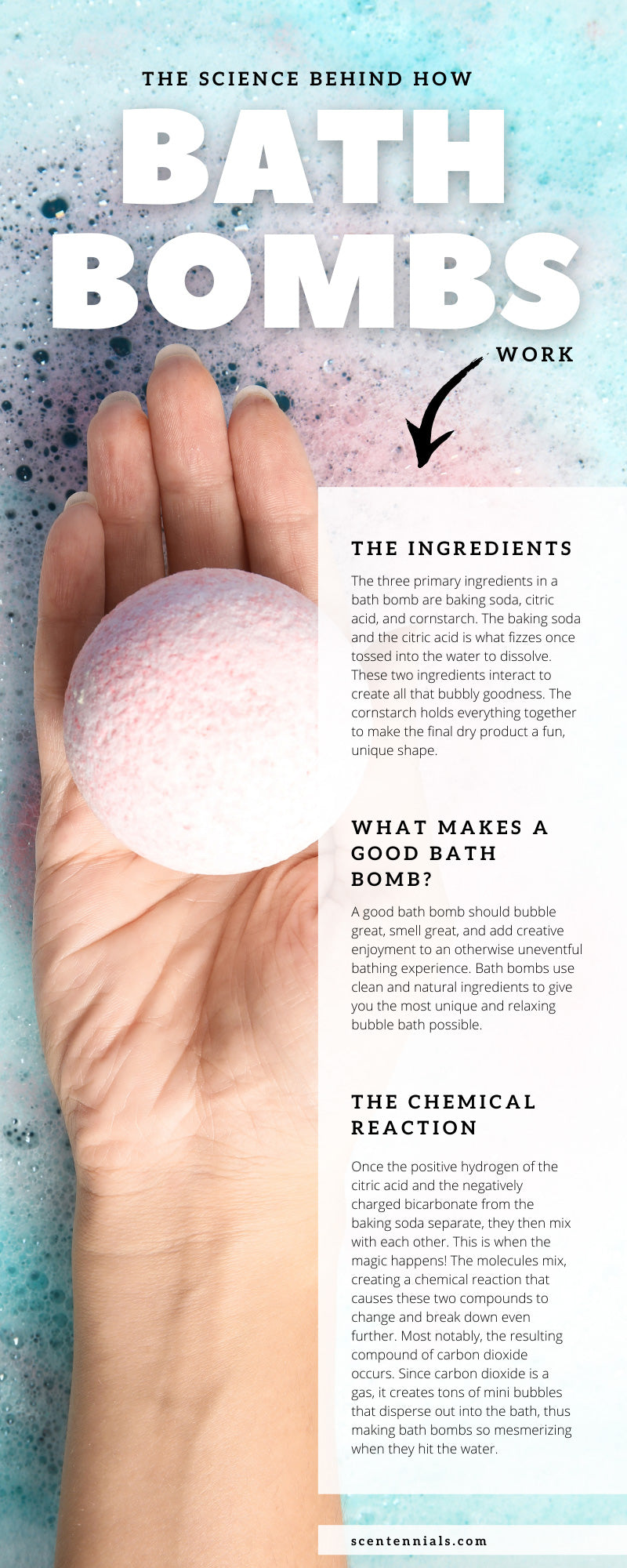
The Science Behind How Bath Bombs Work
After a hard day at work when the weather turns chilly, there’s nothing like a soothing, hot bath. It’s a luxury we all need in our lives as a normal part of self-care, as well as good hygiene. Bathing can also be a terrific time to treat yourself with a little more care and appreciation.
Besides scrubbing down, bathing is a perfect time to relax and unwind, giving us space for mental and emotional healing as well as physical unwinding. One great way to do this is by tossing a bath bomb into the tub before settling in for a long soak.
These colorful little cakes add a good smell, pretty colors, and usually have other fun benefits like natural oils and ingredients that are great for our skin and bodies. Here at Scentennials Products, we offer a wide array of wonderful premium bath bombs and are big fans of these fizzy little delights.
Making quality bath bombs is a pleasure and so is talking about the science behind how bath bombs work. Besides being a fun way to pamper yourself, bath bombs are just plain interesting—a mini marvel of science!
The Ingredients
The three primary ingredients in a bath bomb are baking soda, citric acid, and cornstarch. The baking soda and the citric acid is what fizzes once tossed into the water to dissolve. These two ingredients interact to create all that bubbly goodness. The cornstarch holds everything together to make the final dry product a fun, unique shape.
Scents are also essential. Essence water can be used to add smell as well as wet the powders just enough to stick them together in the mold. Once tossed in a bath, the scents will be released as it dissolves.
For the most part, coloring is added as well, but that’s a matter of preference. A colorful bathtub fizzing and sparkling away certainly is appealing! Lastly, as bath bombs are essentially solid cakes, it’s very easy to mix dry ingredients into them to make them even more luxurious.
Often this will be scented materials such as herbs. Another popular addition is Epsom salt for both the healing properties and herbal scents it provides. For some extra fun, small items such as collectibles, jewelry, soap, or other nice treats are added to the center. As the bath bomb dissolves, the treasure is revealed.
What Makes a Good Bath Bomb?
Surprisingly, it takes common ingredients to make a great bath bomb. Much of these ingredients can be found around the home, which likely contributes to the success and popularity of bath bombs. At Scentennials Products, we firmly believe there’s nothing quite like an item made from a few recognizable ingredients.
With baking soda and citric acid being the two must-have ingredients, you can be sure that what you are soaking in is simple and safe. A good bath bomb really takes advantage of this chemical reaction to create a fizzy and wonderfully bubbly bath. It all comes down to the bubbles, and a well-made bath bomb won’t fall short.
Besides this, the general market has also come to expect some of the extra ingredients mentioned previously. Adding a bath bomb has almost become an equivalent to adding scented bubble bath concoctions and soaps—except they’re simpler, easier to use, contain no strange chemical compounds, and are mess free.
A good bath bomb should bubble great, smell great, and add creative enjoyment to an otherwise uneventful bathing experience. Bath bombs use clean and natural ingredients to give you the most unique and relaxing bubble bath possible.
The Chemical Reaction
Bath bombs are all about citric acid and baking soda. Ultimately, the science behind how bath bombs work is in the chemical reaction between these two simple ingredients. When these two are mixed, they begin to fizz and bubble and erupt into a foamy goodness. This chemical reaction can only happen when water is added to the mix.
So go ahead, toss that colorful ball into your bathtub and watch the magic happen! Taking a deeper look, baking soda is what is referred to as a bicarbonate soda. Its chemical formula is NaHCO3. In water, bicarbonate sodium dissolves very rapidly as the chemical rearranges and bonds in new ways when in contact with water molecules.
In particular, the positively charged Na+ part of the molecule separates from the negatively charged bicarbonate, HCO3-. Meanwhile, the simpler citric acid only makes one change when introduced to water. The positively charged hydrogen ion diverges. Once the positive hydrogen of the citric acid and the negatively charged bicarbonate from the baking soda separate, they then mix with each other. This is when the magic happens!
The molecules mix, creating a chemical reaction that causes these two compounds to change and break down even further. Most notably, the resulting compound of carbon dioxide occurs. This is the same stuff that makes carbonated drinks so fizzy. Since carbon dioxide is a gas, it creates tons of mini bubbles that disperse out into the bath, thus making bath bombs so mesmerizing when they hit the water.
Lastly, since all those great ingredients were carefully mixed into the bath bomb cake, they start to hit the water and react in their own way, too. Epsom salt breaks loose and sinks where it will also dissolve. Herbs and other luxury ingredients pop out and start to steep and release their scents and natural oils. Finally, any added aromas embedded in the three essential ingredients begin to fill the room with rich smells.
The result is an amazing bath product you are sure to love. At Scentennials Products, we have a curated selection of bath bombs that are perfect for treating yourself to a little relaxation and downtime. For such a simple and inexpensive product, bath bombs can add a lot to a self-care schedule and make bath time less of a fuss.

